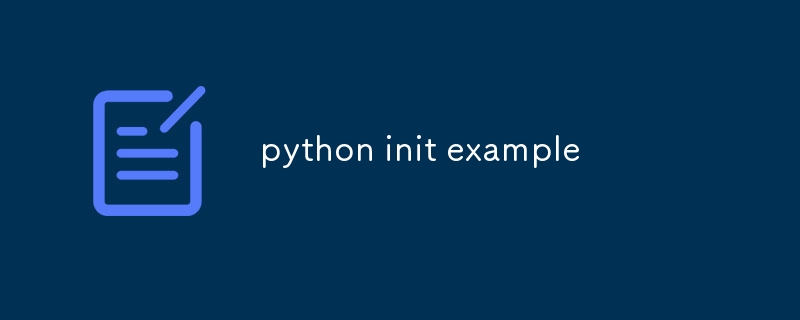python init example
init is a method used in Python to initialize object properties. 1. When creating an instance of the class, __init__ is automatically executed, which is used to set the initial state of the object, such as binding the parameter to the instance through self.name = name. 2. You can set default values for parameters, such as breed="Unknown" and age=1 in the Dog class, making initialization more flexible. 3. Logical verification can be added to init, such as the BankAccount class checks whether balance is negative, improving data security. 4. Note that init is an initialization method rather than a constructor. The object already exists before the method is executed and must be spelled correctly and cannot be written as int or init___. Proper use of __init allows classes to have flexible and robust initial configuration when instantiating, thereby effectively managing object state.

__init__ is a constructor of a class in Python that is used to initialize properties when creating an object. Here is a simple and practical example to help you understand how to use __init__ correctly.

What is __init__ ?
When you create an instance of a class, the __init__ method is automatically executed to set the initial state of the object (such as assignment properties).
Basic usage example: Defining a person's class
class Person:
def __init__(self, name, age):
self.name = name
self.age = age
# Create instance person1 = Person("Alice", 30)
person2 = Person("Bob", 25)
print(person1.name, person1.age) # Output: Alice 30
print(person2.name, person2.age) # Output: Bob 25? illustrate:

-
__init__receivesself(representing the instance itself),nameandageas parameters. -
self.nameandself.agebind values to instances, which can be accessed through instances later.
__init__ with default value
You can also set default values for parameters to make initialization more flexible.
class Dog:
def __init__(self, name, breed="Unknown", age=1):
self.name = name
self.breed = breed
self.age = age
# Use the default value dog1 = Dog("Buddy")
dog2 = Dog("Max", "Golden Retriever", 5)
print(dog1.name, dog1.breed, dog1.age) # Buddy Unknown 1
print(dog2.name, dog2.breed, dog2.age) # Max Golden Retriever 5In this way, even if certain parameters are not passed, there will be no errors.

Type checking or initialization logic in __init__
You can add simple verification or processing logic to __init__ :
class BankAccount:
def __init__(self, owner, balance=0):
self.owner = owner
if balance < 0:
raise ValueError("Balance cannot be negative")
self.balance = balance
def deposit(self, amount):
self.balance = amount
def withdraw(self, amount):
if amount > self.balance:
raise ValueError("Insufficient balance")
self.balance -= amount
# Use example account = BankAccount("Zhang San", 100)
account.deposit(50)
account.withdraw(30)
print(account.balance) # 120 In this example, __init__ not only assigns values, but also performs data legality checks.
Things to note
-
__init__is not a "constructor", but a "initialization method". The object is created before__init__is executed. - Do not write it as
__int__or__init___, the spelling must be correct. - If the class does not define
__init__, Python will use the parent class's (such as the defaultobject.__init__).
Basically that's it. The core of __init__ is: when creating an object, set the initial value . Using it well can make the class more flexible and robust.
The above is the detailed content of python init example. For more information, please follow other related articles on the PHP Chinese website!

Hot AI Tools

Undress AI Tool
Undress images for free

Undresser.AI Undress
AI-powered app for creating realistic nude photos

AI Clothes Remover
Online AI tool for removing clothes from photos.

Clothoff.io
AI clothes remover

Video Face Swap
Swap faces in any video effortlessly with our completely free AI face swap tool!

Hot Article

Hot Tools

Notepad++7.3.1
Easy-to-use and free code editor

SublimeText3 Chinese version
Chinese version, very easy to use

Zend Studio 13.0.1
Powerful PHP integrated development environment

Dreamweaver CS6
Visual web development tools

SublimeText3 Mac version
God-level code editing software (SublimeText3)

Hot Topics
 Laravel lazy loading vs eager loading
Jul 28, 2025 am 04:23 AM
Laravel lazy loading vs eager loading
Jul 28, 2025 am 04:23 AM
Lazy loading only queries when accessing associations can easily lead to N 1 problems, which is suitable for scenarios where the associated data is not determined whether it is needed; 2. Emergency loading uses with() to load associated data in advance to avoid N 1 queries, which is suitable for batch processing scenarios; 3. Emergency loading should be used to optimize performance, and N 1 problems can be detected through tools such as LaravelDebugbar, and the $with attribute of the model is carefully used to avoid unnecessary performance overhead.
 Object-Relational Mapping (ORM) Performance Tuning in PHP
Jul 29, 2025 am 05:00 AM
Object-Relational Mapping (ORM) Performance Tuning in PHP
Jul 29, 2025 am 05:00 AM
Avoid N 1 query problems, reduce the number of database queries by loading associated data in advance; 2. Select only the required fields to avoid loading complete entities to save memory and bandwidth; 3. Use cache strategies reasonably, such as Doctrine's secondary cache or Redis cache high-frequency query results; 4. Optimize the entity life cycle and call clear() regularly to free up memory to prevent memory overflow; 5. Ensure that the database index exists and analyze the generated SQL statements to avoid inefficient queries; 6. Disable automatic change tracking in scenarios where changes are not required, and use arrays or lightweight modes to improve performance. Correct use of ORM requires combining SQL monitoring, caching, batch processing and appropriate optimization to ensure application performance while maintaining development efficiency.
 A Deep Dive into PHP's Internal Garbage Collection Mechanism
Jul 28, 2025 am 04:44 AM
A Deep Dive into PHP's Internal Garbage Collection Mechanism
Jul 28, 2025 am 04:44 AM
PHP's garbage collection mechanism is based on reference counting, but circular references need to be processed by a periodic circular garbage collector; 1. Reference count releases memory immediately when there is no reference to the variable; 2. Reference reference causes memory to be unable to be automatically released, and it depends on GC to detect and clean it; 3. GC is triggered when the "possible root" zval reaches the threshold or manually calls gc_collect_cycles(); 4. Long-term running PHP applications should monitor gc_status() and call gc_collect_cycles() in time to avoid memory leakage; 5. Best practices include avoiding circular references, using gc_disable() to optimize performance key areas, and dereference objects through the ORM's clear() method.
 Integrating PHP with Machine Learning Models
Jul 28, 2025 am 04:37 AM
Integrating PHP with Machine Learning Models
Jul 28, 2025 am 04:37 AM
UseaRESTAPItobridgePHPandMLmodelsbyrunningthemodelinPythonviaFlaskorFastAPIandcallingitfromPHPusingcURLorGuzzle.2.RunPythonscriptsdirectlyfromPHPusingexec()orshell_exec()forsimple,low-trafficusecases,thoughthisapproachhassecurityandperformancelimitat
 The Serverless Revolution: Deploying Scalable PHP Applications with Bref
Jul 28, 2025 am 04:39 AM
The Serverless Revolution: Deploying Scalable PHP Applications with Bref
Jul 28, 2025 am 04:39 AM
Bref enables PHP developers to build scalable, cost-effective applications without managing servers. 1.Bref brings PHP to AWSLambda by providing an optimized PHP runtime layer, supports PHP8.3 and other versions, and seamlessly integrates with frameworks such as Laravel and Symfony; 2. The deployment steps include: installing Bref using Composer, configuring serverless.yml to define functions and events, such as HTTP endpoints and Artisan commands; 3. Execute serverlessdeploy command to complete the deployment, automatically configure APIGateway and generate access URLs; 4. For Lambda restrictions, Bref provides solutions.
 Building Immutable Objects in PHP with Readonly Properties
Jul 30, 2025 am 05:40 AM
Building Immutable Objects in PHP with Readonly Properties
Jul 30, 2025 am 05:40 AM
ReadonlypropertiesinPHP8.2canonlybeassignedonceintheconstructororatdeclarationandcannotbemodifiedafterward,enforcingimmutabilityatthelanguagelevel.2.Toachievedeepimmutability,wrapmutabletypeslikearraysinArrayObjectorusecustomimmutablecollectionssucha
 What is Laravel Octane?
Jul 28, 2025 am 04:12 AM
What is Laravel Octane?
Jul 28, 2025 am 04:12 AM
LaravelOctaneisaperformance-boostingpackagethatimprovesresponsetimesandthroughputbyservingLaravelapplicationsviaSwoole,OpenSwoole,orRoadRunner.1.UnliketraditionalPHP-FPM,whichbootsLaraveloneveryrequest,Octaneloadstheapponceandkeepsitinmemory.2.Thisel
 Laravel raw SQL query example
Jul 29, 2025 am 02:59 AM
Laravel raw SQL query example
Jul 29, 2025 am 02:59 AM
Laravel supports the use of native SQL queries, but parameter binding should be preferred to ensure safety; 1. Use DB::select() to execute SELECT queries with parameter binding to prevent SQL injection; 2. Use DB::update() to perform UPDATE operations and return the number of rows affected; 3. Use DB::insert() to insert data; 4. Use DB::delete() to delete data; 5. Use DB::statement() to execute SQL statements without result sets such as CREATE, ALTER, etc.; 6. It is recommended to use whereRaw, selectRaw and other methods in QueryBuilder to combine native expressions to improve security







